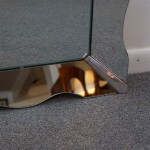How to Make Glass Into an Antique Mirror
Creating an antique mirror effect on glass involves applying a chemical solution that simulates the look of aged mercury glass. This process differs from traditional silvering methods, which involve highly toxic chemicals like mercury. The antique effect is achieved by mimicking the deterioration patterns seen in genuine antique mirrors, including spotting, hazing, and discoloration.
Several techniques exist for antiquing glass. One common method utilizes a two-part solution containing silver nitrate and a reducing agent. Another involves applying specialty antiquing paints or sprays designed for this specific purpose. This article will focus on the chemical antiquing process, as paint-based methods are relatively straightforward and generally well-explained on the product packaging.
Before beginning, gather the necessary materials. These include the glass sheet to be antiqued, safety goggles, gloves, a respirator mask (essential for the silver nitrate method), distilled water, clean spray bottles, a squeegee, lint-free cloths, and the chosen antiquing solution. Ensure the glass is thoroughly cleaned and free of any grease, dust, or fingerprints. Any imperfections on the glass surface will be magnified by the antiquing process.
For the silver nitrate method, prepare the two solutions separately according to the manufacturer's instructions. These solutions are usually labeled as "Solution A" and "Solution B." It is crucial to follow the safety precautions provided by the manufacturer, as silver nitrate can cause skin stains and eye irritation. The respirator mask is vital due to the potential release of harmful fumes during the chemical reaction.
Once the solutions are prepared, the application process can begin. This is best done in a well-ventilated area, preferably outdoors or in a dedicated workspace with proper exhaust ventilation. Start by lightly misting the clean glass surface with distilled water. This helps to ensure an even application of the antiquing solution. Next, spray "Solution A" onto the dampened glass, followed immediately by "Solution B." The reaction between the two solutions will cause the silvering effect to appear almost instantly.
The application technique can be varied to achieve different antique effects. For a more uniform look, apply both solutions in even, overlapping sprays. For a more mottled or aged appearance, vary the spray distance and intensity. A squeegee can be used to manipulate the solution and create streaks or patterns. Experimenting with different techniques on scrap pieces of glass is highly recommended before working on the final piece.
After applying the solutions, allow the glass to sit undisturbed for the recommended time, typically specified by the manufacturer. This allows the chemical reaction to complete and the antiquing effect to fully develop. Once the reaction is complete, gently rinse the glass with distilled water and carefully dry it with a lint-free cloth.
For increased durability and protection, consider sealing the antiqued surface. A clear sealant, such as a spray-on acrylic or varnish designed for glass, can prevent the antiqued finish from scratching or deteriorating over time. Apply the sealant according to the manufacturer's instructions, ensuring an even coat and proper drying time.
An alternate method involves specialized antiquing paints or sprays. These products offer a simplified approach and often come in various pre-mixed color tones, making it easier to achieve the desired antique effect. When using these products, carefully follow the manufacturer's instructions for surface preparation, application, and drying times.
Regardless of the chosen method, proper preparation and careful execution are key to achieving a desirable antique mirror finish. Patience is also essential, as the chemical reaction and drying times must be respected for optimal results. By understanding the process and following the necessary precautions, one can transform ordinary glass into a beautiful, antique-looking piece.
Different antiquing solutions offer varying degrees of control over the final appearance. Some solutions produce a highly reflective, almost mirrored surface, while others create a more subdued, hazy effect. Researching different products and their characteristics is advisable to select the solution best suited for the desired aesthetic.
The age and style of the intended antique look should also influence the chosen technique. For instance, a heavily mottled and distressed finish might be appropriate for replicating a very old, weathered mirror, whereas a more subtle, evenly antiqued surface might be more suitable for a less aged appearance.
Finally, remember that practice makes perfect. Experimenting with different techniques and solutions on smaller glass pieces before tackling a large project is highly recommended. This allows for a greater understanding of the process and helps to develop the skills necessary to achieve the desired antique mirror effect.

How To Turn Ordinary Glass Into An Antique Mirror

How To Antique A Mirror Tutorial Jenna Sue Design

How To Turn A Thrifted Picture Frame Into Mirror Sweet Southern Oaks

How To Antique A Mirror Tutorial Jenna Sue Design

How To Turn Glass Into An Antique Mirror The Morris Mansion

How To Turn Ordinary Glass Into An Antique Mirror

How To Make A Mirror With Pictures Wikihow

Beautiful Easy Faux Mercury Glass Diy Mirror Tutorial This Life

How To Turn Ordinary Glass Into Looking Interior Frugalista

How To Quickly Turn Glass Mirror In 4 Steps Spray Paint Home Decor Ideas








